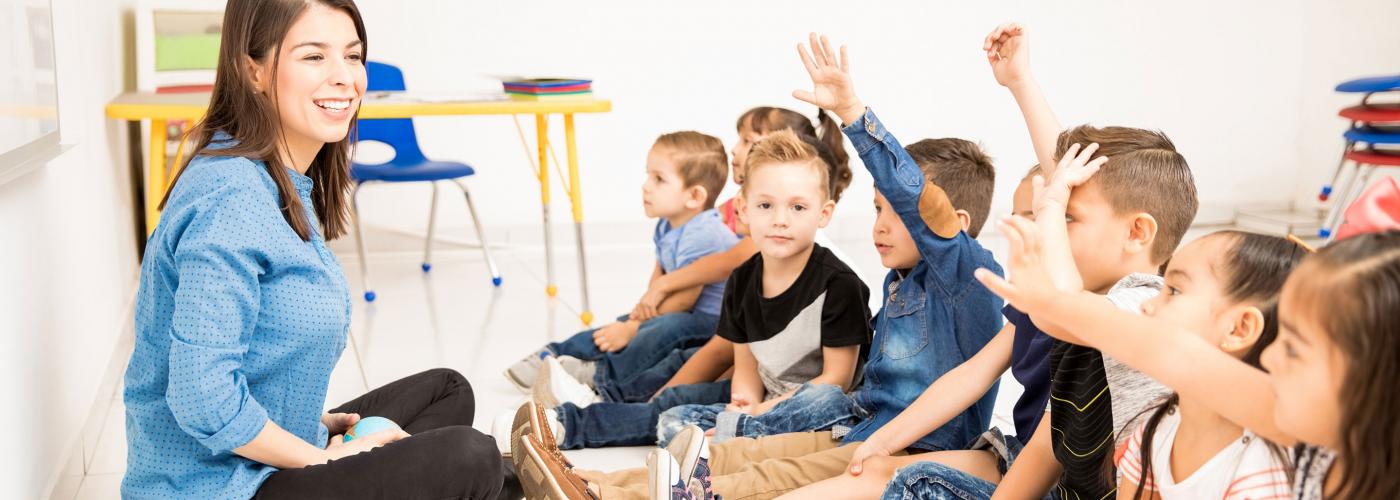


If you can't find the information you need in our answers to General questions or Questions about online learning, please get in touch and someone from our team will be happy to help.
Immersion into English language is an important part of communicative English language teaching. Providing students with an English-speaking environment, that is not reliant on their mother tongue, encourages children to adapt and follow instructions in English.
Children imitate what they see and hear, and are quick to memorise new information. Our classes feature a balance of stirring activities (active tasks that incorporate movement) and settling tasks (fewer active tasks such as writing, colouring, arts & crafts) to cater for the various learning styles.
By engaging in tasks in an English environment, children naturally start to pick up the language used in the classroom. For example, a phrase such as "pass me the scissors please" can be visual (as they see the item), aural (hearing the teacher model the phrase) and kinaesthetic (physically using the item).
The answer is, due to their differing objectives, both methods are correct.
In most local school systems, the focus is on memorising content to pass school examinations. We often note that local students have more advanced receptive skills (reading and listening) than productive skills (speaking and writing). This can also be attributed to larger class sizes in most schools, and the teaching style of disseminating information through dictation and reading activities, with limited opportunities for students to actually practice what they are learning.
At EfA, our aim is to enhance students’ productive English skills by immersing them in an English speaking environment. Smaller class sizes - with a maximum of nine students per class - allow all students to have opportunity to practise their English skills as well as build their confidence in speaking. Students can then apply their acquired language skills to practical tasks that will benefit them in future where they are required to speak English, for instance at school, university or at work.
Classes feature different types of student interaction patterns through games, pair and group work, discussions, presentations, drama and role-plays.
Every child will progress at a slightly different pace. Generally, for those students that have no background of studying in an English-speaking environment or that don’t use English outside of class (for example, to communicate with their domestic helper) then it will usually take around three to five lessons for them to fully integrate into an English class.
Our classes are interactive and communicative. Students are encouraged to participate as much as they can. Children learn best when they are enjoying themselves, so we make sure classes are fun and engaging for our learners.
To speed up your child’s progress, our range of after-school classes provide even more opportunities for students to practice what they are learning. You can find more information on our English Club on the pages for Kindergarten, Primary and Secondary, or get in touch with our Learning Centre staff.
Of course. In fact, this is often when the best learning takes place!
The way we respond to a child’s mistakes is crucial to their development. Handling a child’s mistakes in a careful and encouraging way plays an important part in their linguistic development. On the other hand, responding negatively can make them afraid to speak up and hinder their development.
Our lessons are structured to be enjoyable and interactive – we want our students to enjoy their learning experience as part of a class. Therefore, it is preferred that all course content is discussed and studied together as a group.
If you would like your child to do homework, why not put aside time to review what they have learnt each week with you. You will find that if your child explains what they have studied, in English, they will deepen their understanding.
Communicative methodology requires interactive learning. For some students this is the complete opposite to teaching methods used at their school. Our lessons encourage student participation, discussion and communication, so the classroom environment will often appear lively and high-spirited.
From time to time a student may become excitable when participating in a game or activity, which could disrupt the class. Our teachers are trained to handle these situations. In the event that a student continually disrupts the lessons, the teacher will inform our Learning Centre Management Team and we will speak to the student and/or the student’s parents. All such instances are handled in complete confidence.
We use the live video conferencing platform Zoom. It is completely free to set up an account and easy to navigate.
Yes, students have the same access to their teacher, it is just in a virtual space rather than a physical classroom. The use of multi-media, zoom and online tools enable learners to fully immerse themselves in the learning experience.
All lesson content is shown on the screen and many visuals, questions and interactive games are used to engage your child. In addition, tasks are built around songs, story videos and TPR (Total Physical Response) activities to keep our youngest learners moving, active and motivated throughout.
To help students focus, we typically schedule two short breaks in a 60-minute lesson, encourage students to do stretches, drink water and go to the toilet, and find something to keep them focussed.
Still unsure? Hear from our Learning Centre Manager and see clips from online lessons in our video.
We teach students how to use the different Zoom tools to enable them to have an engaging and interactive learning experience. You will need to have a Zoom account (the free account is fine) and download recent updates to ensure you have access to the latest features of Zoom.
If you need any technical support during a lesson, you can always call us on our hotline on +853 2870 5784 or +853 6612 8030.